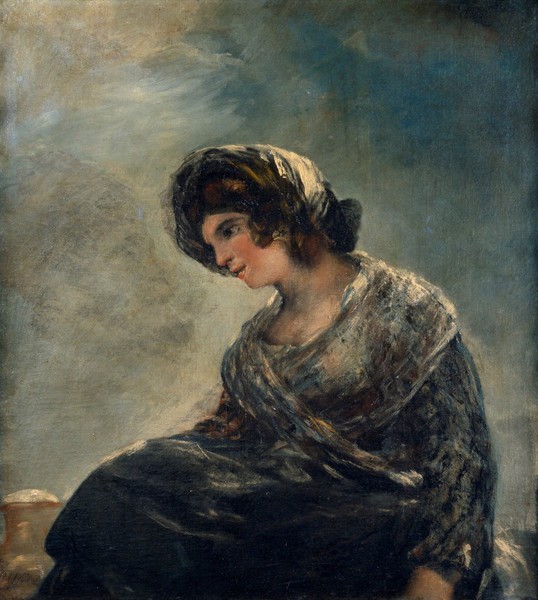- Cronología
- 1825 - 1827
- Ubicación
- The Prado National Museum. Madrid, Madrid, Spain
- Dimensiones
- 74 x 68 cm
- Técnica y soporte
- Oil on canvas
- Reconocimiento de la autoría de Goya
- Documented work
- Titular
- El Prado National Museum
- Ficha: realización/revisión
- 17 Jun 2010 / 15 Jun 2023
- Inventario
- (P02899)
Goya (on the side).
This work was painted in Bordeaux. Leocadia Zorilla inherited it on Goya's death, and sold it to Juan Bautista de Muguiro, a good friend of Goya's in Bordeaux. The letter which Leocadia wrote to Muguiro on 9 December 1829 has survived, in which she offers him the painting for a sum no lower than an ounce of gold, as she had been instructed by Goya. The letter was published in its entirety by Sánchez Cantón in 1947.
It remained in the Muguiro family until the buyer's nephew, Fermín de Muguiro y Beruete, the Third Count of Muguiro and Alto Bacilés bequeathed it to the Prado Museum. It was entrusted to the museum on 5 December 1945.
The Milkmaid of Bordeaux is one of Goya's most acclaimed works. Painted in the last years of his life, it is striking for its cheerful colouring and bright lighting, which contrast with the dark monochromes which dominate the rest of the works from his final years. Some experts see in this work the most accomplished example of Goyaesque impressionism, above all in the execution of the shawl which covers the maid's shoulders.
The woman depicted in this genre painting, which may well be a portrait, has not been identified. She is seated, probably on a saddle on which she rode when she delivered the milk, as suggested by the low point of view. She is wearing a white cloth on her head which covers part of her brown hair, a shawl rendered in bluish tones and yellow and white flecks which crosses over her chest, and a black skirt. Her figure stands out against a greenish-blue sky with white touches. By her side we can make out a pitcher brimming with white milk. On the curve of the pitcher there is an inscribed signature which defends Goya's authorship, although Juliet Wilson has cast doubt on its authenticity. The expert thinks that the author of this work may have been Rosario Weiss, the daughter of Leocadia Zorrilla. We know that Rosario also painted, and that Goya held her and her artistic skills in high esteem, but in 1827 she was only thirteen, and it seems unlikely that such a young girl would be capable of creating such a magnificent work. Due to a lack of evidence to support the theory, most academics still support the attribution of this work to Goya.
-
Goya 1900Ministerio de Instrucción Pública and Bellas ArtesMadrid1900consultant editors Aureliano de Beruete, Alejandro Ferrant, Marqués de Pidal and Ricardo Velázquez. May 1900cat. 79
-
Pintura española de la primera mitad del siglo XIXSociedad Española de Amigos del ArteMadrid1913cat. 141
-
Pinturas de GoyaMuseo Nacional del PradoMadrid1928consultant editor Fernando Álvarez de Sotomayor. From April to May 1928cat. 17
-
Goya y el espíritu de la IlustraciónMuseo Nacional del PradoMadrid1988from October 6th to December 18th 1988. Exhibited also at Museum of Fine Arts, Boston, January 18th to March 26th 1989; The Metropolitan Museum of Art, Nueva York, May 9th to July 16th 1989, Madrid curator Manuela B. Mena Marqués, scientific directors Alfonso E. Pérez Sánchez and Eleanor A. Sayrecat. 124
-
Goya. 250 AniversarioMuseo Nacional del PradoMadrid1996consultant editor Juan J. Luna. From March 29th to June 2nd 1996cat. 170
-
Realidad e imagen. Goya 1746 – 1828Museo de ZaragozaZaragoza1996consultant editor Federico Torralba Soriano. From October 3th to December 1st 1996cat. 68
-
Goya’s last WorksThe Frick Art CollectionNew York2006consultant editors Jonathan Brown and Susan Grace Galassi. From February 22nd to May 14th 2006cat. 12
-
Goya y el Mundo ModernoMuseo de ZaragozaZaragoza2008organized by the Fundación Goya en Aragón at the Museo de Zaragoza, consultant editors Valeriano Bozal and Concepción Lomba Serrano. From December 18th 2008 to March 22nd 2009cat. 28
-
Goya e il Mondo ModernoPalazzo RealeMilan2010organized by SEACEX, Palazzo Reale and Fundación Goya en Aragón, consultant editors Valeriano Bozal and Concepción Lomba Serrano. From March 17th to June 27th 2010cat. 24
-
Expérience GoyaLille2021cat. 32
-
L'œuvre peint de Goya. 4 volsParís1928-1950vol. I, p. 298, cat. 277
-
De la estancia bordelesa de GoyaArchivo Español del ArteMadridMadrid1974pp. 62-63
-
Vie et ouvre de Francisco de GoyaParísOffice du livre1970pp. 356, 361, cat. 1667 y p. 25 (il.)
-
BarcelonaPolígrafa1970vol. I, p. 389, cat. 767
-
L’opera pittorica completa di GoyaMilanRizzoli1974p. 137, cat. 691
-
Francisco de Goya, 4 vols.ZaragozaCaja de Ahorros de Zaragoza, Aragón y Rioja1980-1982vol. IV, p. 221 y p. 212 (il.)
-
Goya y el espíritu de la IlustraciónMadridMuseo del Prado1988p. 376, cat. 124 y p. 377 (il.)
-
Goya. 250 AniversarioMadridMuseo del Prado1996p. 435, cat. 170 y p. 277 (il.)
-
Realidad e imagen. Goya 1746 – 1828MadridGobierno de Aragón y Electa España1996p. 188. cat. 68 y p. 189 (il.)
-
Goya’s last worksNew YorkThe Frick Collection and Yale University Press2006p. 118, cat. 12 y p. 119 (il.)
-
Expérience Goya (cat. expo)LilleRéunion des Musées Nationaux2021pp. 78-79
